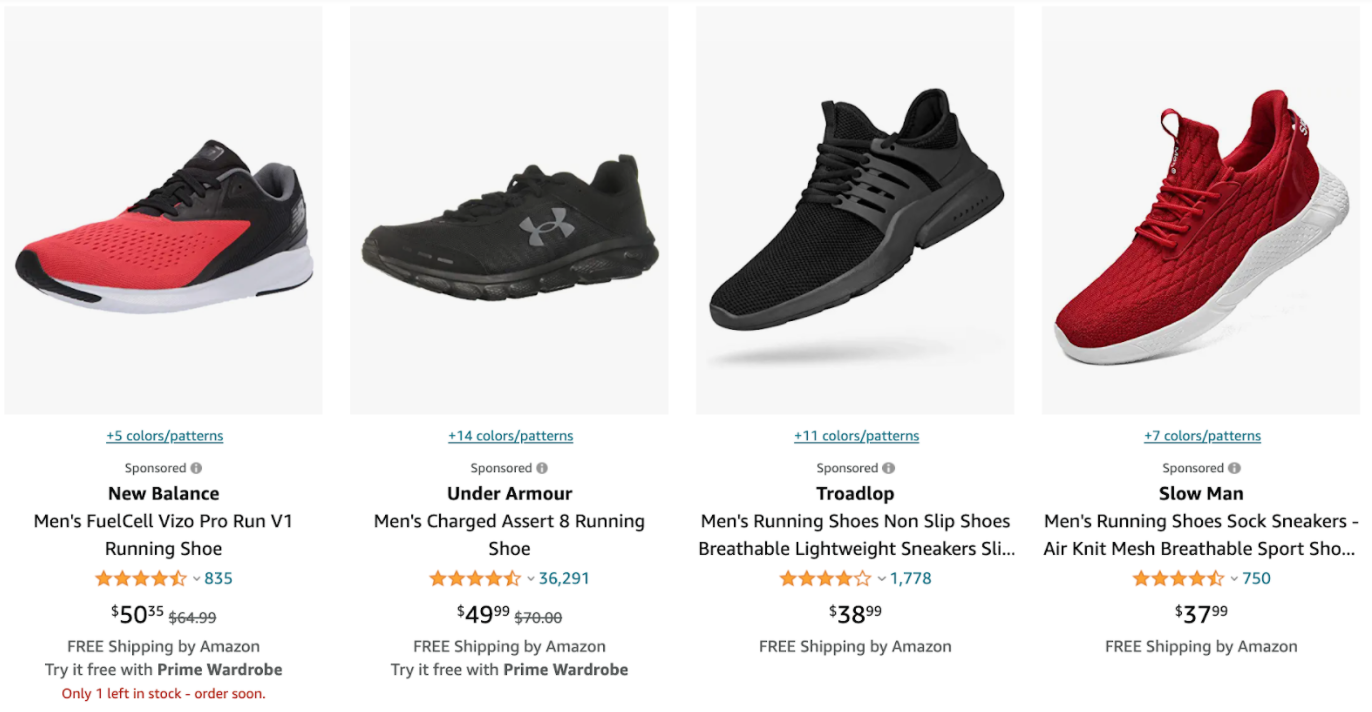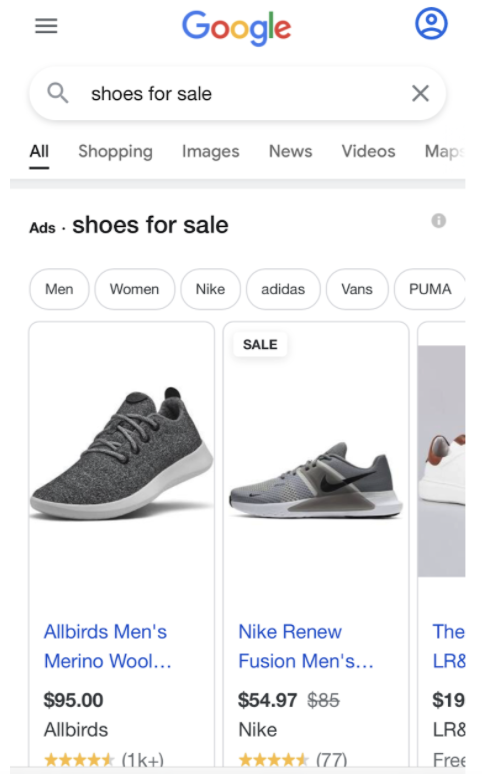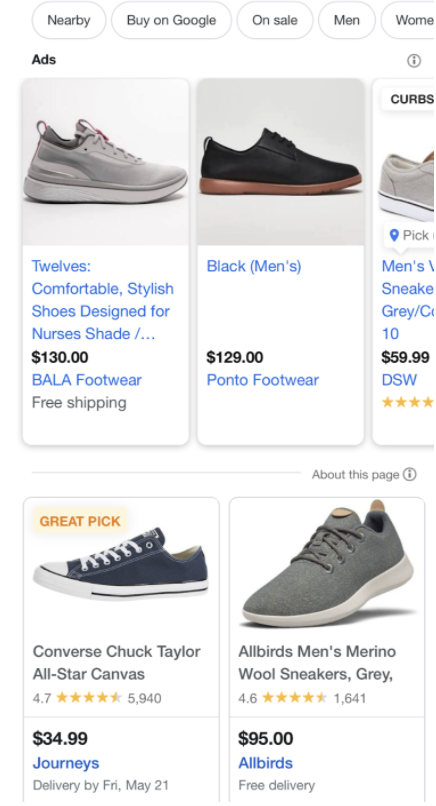For most ecommerce vendors, digital advertising is essential for continued success. However, many brands may ask themselves, “What online advertising platform is right for us?” In this post, we discuss three popular ecommerce platforms that we believe offer brands the best chance to raise their visibility and generate sales.
Amazon
Amazon advertising helps brands connect with potential buyers by allowing them to bid on specific keywords and placements to show higher in search results. This can generate additional sales and even potentially improve the organic ranking of products over time.
After submitting products and getting approval, brands can quickly and easily set up campaigns and ad groups using sponsored brand, sponsored product, and other campaign types.

An example of a Sponsored Brands ad at the top of the page which shows 3 unique ASINs and a link to the brand’s storefront page.

An example of Sponsored Products at the top of the search results. Note that some brands might get multiple ads on the top of the search results as well as throughout the rest of the search results pages.
An example of Sponsored Brand Videos within the search results page on a mobile device.
Why We Like Amazon
No Website, No Problem
The platform enables brands the ability to sell products without the need for an expensive website – making the barrier to entry extremely low for most brands.
Begin Advertising In Minutes
Unlike Google, Pinterest, and other platforms, Amazon’s simple ad setup and interface means that brands can quickly choose products to advertise and start showing products to potential customers in a matter of minutes.
Multiple Campaign Types From Which To Choose
Amazon offers multiple campaign types that enable everyone from the veteran ecommerce master to the novice beginner to advertise on their platform. Just some of the types of campaigns that can be set up include, but are not limited to:
- Sponsored Products
- Automatic Targeting Campaigns
- Manual Targeting Campaigns
- Sponsored Brands
- Sponsored Brands Video
Likely Purchasers Use And Trust Amazon
When shoppers are looking to buy something online, Amazon is a top destination. Amazon has earned this distinction through years of great customer service, competitive prices, and more. Because of this, few platforms can rival the trust buyers have in Amazon.
Potential Drawbacks For Amazon
Referral Fees
In addition to advertising fees, Amazon also charges an additional fee which can potentially be prohibitive. This fee comes as a percentage of the sale, and is often around 15% – though this varies by product category.
Strict Quality Standards
In addition to various fees, Amazon holds sellers against strict shipping times, confirmation emails, order cancellation rates, and more criteria which can be overwhelming for some.
“Buy Box” Issues
To be eligible for advertising on Amazon, a product must win the buy box. Brands that have a hard time getting and maintaining the buy box on Amazon may find it difficult to generate consistent advertising metrics.
What Brands Are A Best Fit For Amazon Advertising
- Brands who sell products with high profit margins.
- Brands that can maintain a healthy inventory of products.
Google Shopping
Though not as well-known as Amazon, Google Shopping is still a major player in the field of ecommerce advertising. Google Shopping allows brands to display their products every time a relevant search is made – giving brands the ability to greatly expand the visibility of their products to a wide audience.
Brands looking to leverage the power of Google Shopping campaigns simply need to build a shopping feed in their Google Merchant Center account that contains the products they wish to advertise. Once this is properly set up, all advertising is controlled through the Google Ads interface.

An example of shopping ads appearing within the search results for the query of “shoes for sale.”

An example of shopping ads within the shopping tab of Google for the query of “shoes for sale.”
Why We Like Google Shopping
Specific Bids for Specific Products
Unlike Amazon, Google Shopping Ads allow brands to set product specific bids without the need for elaborately-designed campaign and ad group structures.
Unmatched Targeting And Bid Adjustment Options
In addition to being able set unique bids on specific products, brands can leverage the power of Google to set up adjust bids and/or target products based on factors including, but not limited to:
- Time Of Day
- Day Of Week
- Location
- Gender
- Age
- Device
- Audience
Smart Bidding Campaigns
Google offers one of the best automated campaign types around in the form of their Smart Shopping campaigns. Through Smart Shopping campaigns, Google uses its machine learning to optimize campaigns to meet brand-specific goals, such as a target return on ad spend. In addition, smart campaigns are great for brands with limited time and resources or little experience in managing PPC campaigns.
No Referral Fees
Unlike Amazon ads which take users to a product page on Amazon, Google Shopping ads direct people to the brand’s actual website. Because the sale occurs on the brand’s website, referral fees – such as the ones seen on Amazon – do not apply. All that brands pay for are the ad clicks themselves, which can make Google Shopping ads incredibly efficient in terms of ROI.
Potential Drawbacks To Google Shopping
Longer Setup Time
Depending on the amount of items to be advertised, shopping feeds can be very time-consuming in their setup and ongoing maintenance. In addition to shopping feed management, adjusting bids, bid adjustments, and targeting can consume large amounts of time.
Google Is Aimed At A More General Audience
Despite adjustments and enhancements to Google Shopping over the years, the fact remains that Google is a general search engine which is used by a wide variety of people. On the other end of the spectrum is Amazon, which people use exclusively for purchasing goods online. Simply put, people looking to buy are more likely to use Amazon to complete a purchase than Google.
Lack of Keyword Targeting
When utilizing Google Shopping ads, brands cannot target specific keywords. While this may save time in the initial setup of a campaign, this also means brands have much less control over what search terms trigger ads. Because of this, it is extremely important to regularly mine search term reports to find those terms which should be added as negative keywords at the account, campaign, or ad group level.
What Brands Are A Best Fit For Google Shopping
- Brands looking to greatly improve visibility while simultaneously growing sales.
- Brands looking to show products to a wider audience.
Pinterest advertising enables brands to market their products to users with promoted ads appearing as pins within the organic results of a user’s search.
Unlike other platforms, Pinterest is a platform used primarily for discovery and inspiration – meaning users of Pinterest are less likely to be searching for specific items and users are higher in the marketing funnel than those on other platforms.
An example of Pinterest ads for Hoka, New Balance, and Ebay appearing within search results for “running shoes”
Why We Like Pinterest
Video Advertising For Products
While many platforms offer rich images of products being advertised, Pinterest allows brands to use video content as a substitute – allowing brands to showcase their products in an attention-grabbing format which really captures the eye of the user.
Diverse Advertising Options
Unlike Google Shopping, Pinterest offers a variety of advertising options for brands to reach consumers based on their goals focusing on the areas of awareness, consideration, and conversions.

Pinterest offers 5 primary campaign types to choose from which focus on building awareness, driving conversions, and getting conversions.
Catalog Sales
If a brand is already running Google Shopping ads, then setting up catalog sales in Pinterest is quick and easy. In fact, usually, all a brand needs to do is simply make a copy of their existing Google Shopping feed, rename a few columns, and save the feed’s file on their website. Once this is done, brands can begin selecting which products they wish to advertise and finish building out their campaigns and ad groups.
Potential Drawbacks To Pinterest
Less Diverse Audience Than Other Platforms
While diversifying its audience, Pinterest’s audience still skews heavily towards 20-40 year old women, meaning that some product categories will potentially perform much better on the platform than others.
Platform Layout
When compared to the other major platforms discussed here, we have found that Pinterest’s platform is more cumbersome and harder to navigate than Amazon and Google. While we attributed this to a learning curve at first, after using the platform for months, we still find it to be a less user-friendly experience than other platforms. However, Pinterest’s platform is always evolving, and will undoubtedly improve over time.
What Brands Are A Best Fit For Pinterest
- Brands that sell visually appealing products.
- Brands looking to diversify and expand marketing efforts to newer platforms.
Ready to start advertising online for your ecommerce brand? Any of these platforms are a great start. If you need help setting up or managing your ad campaigns, reach out to WTM. Our PPC specialists are experienced in all of these platforms and can help you get the best return on investment.
